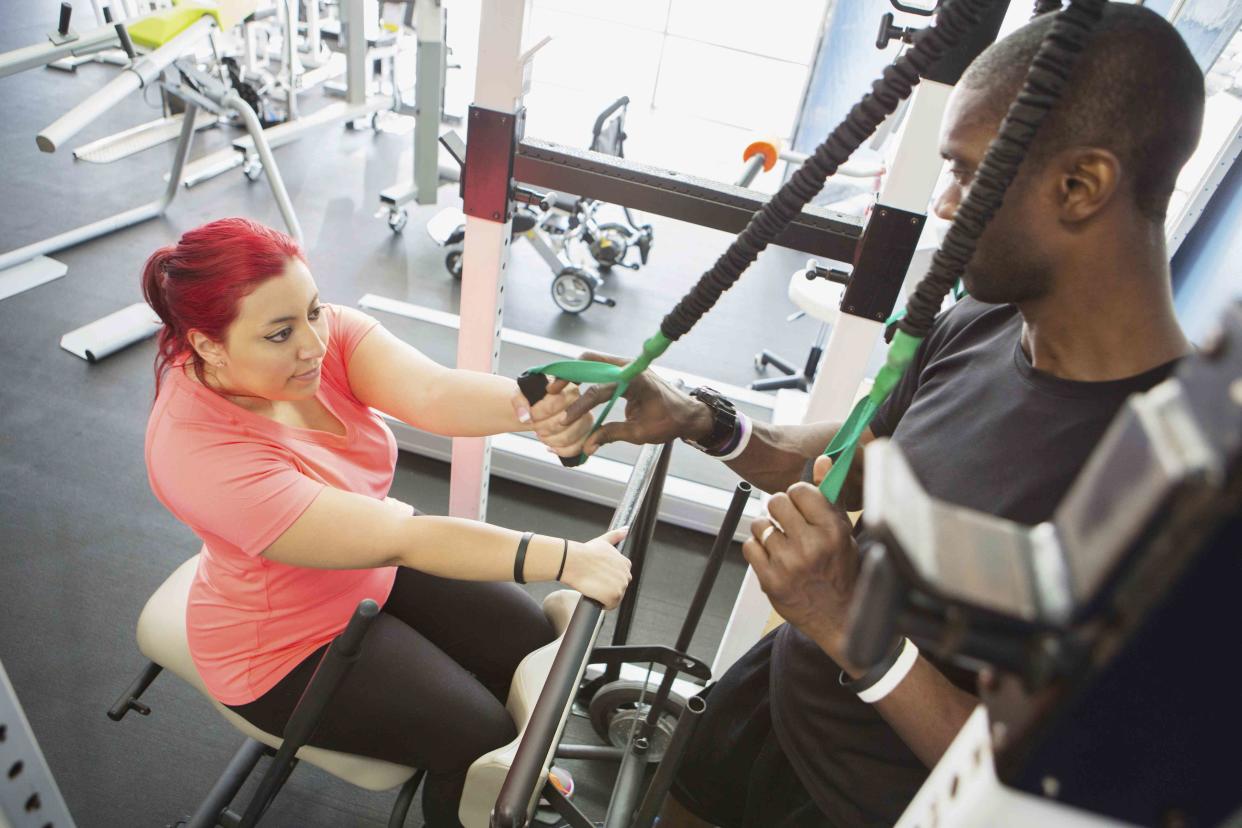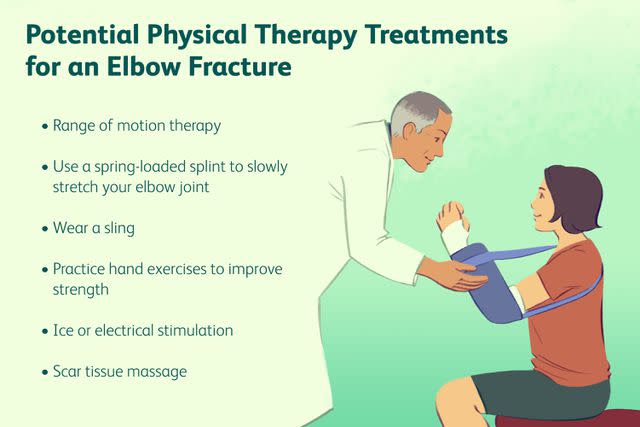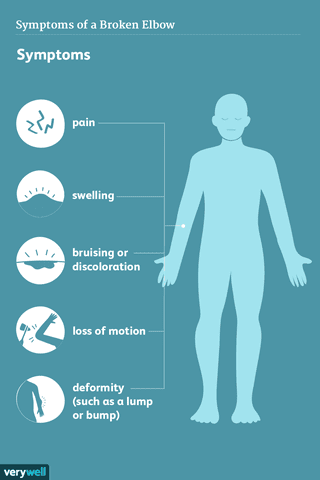Physical Therapy After an Elbow Fracture

Getty Images / PhotoAbility
Medically reviewed by Cara Beth Lee, MD
Physical therapy is commonly pursued after an elbow fracture. This can help speed healing and restore the range of motion of the elbow joint. It also improves the strength and mobility of not only your elbow but your arm, shoulder, or wrist as well.
Physical therapy can go a long way toward preventing the loss of joint mobility that can affect your work and ability to perform daily tasks.
This article discusses the goals of physical therapy for a broken elbow and which types of exercises you can expect to do during your recovery.

Verywell / Mira Norian
Related:Signs and Symptoms of an Elbow Fracture
Why You May Need Physical Therapy
The elbow is a joint where the upper arm bone, called the humerus, meets the radius and ulna bones of the forearm. The bony end of the ulna is called the olecranon process. This is the bone you feel when you are leaning your elbow on a table. The bones of the elbow are connected by ligaments on the inner and outer parts of your arm.
The most common cause of an elbow fracture is trauma to your arm near your elbow. This can happen after a fall on your elbow or outstretched arm, or during a car crash or sports-related accident. These injuries tend to happen suddenly.

A blunt force impact can fracture one of the following bones:
The radial head, located at the top of the smaller forearm bone
The distal humerus, located at the lower part of the upper arm bone
The olecranon, also known as the ball of the elbow joint
Compound fractures and dislocations can also occur. A fracture with dislocation is especially problematic, causing long-term pain and stiffness. Moreover, many people will develop excessive bone growth (called ossification) and a loss of joint mobility.
While your elbow heals, it is important to keep it from getting too stiff or weak. This is why you should work with a physical therapist early on while you are still wearing a brace or sling.
What Happens After an Elbow Is Fractured
If you have had an elbow fracture, your healthcare provider will start by reducing the fracture. During this process, your elbow bones are put in the correct position so that optimal healing can take place.
If the fracture is severe, your surgeon may recommend an open reduction internal fixation (ORIF). During this surgical procedure, the bones are manually realigned. Screws, plates, or wires are inserted to hold the bones in place.
After your elbow fracture is reduced, you may need to wear a brace or a sling. Occasionally, an elbow fracture will be put in a cast.
With that said, immobilizing an elbow fracture can be extremely risky. This is because it may lead to severe stiffness and a permanent loss of joint mobility.
This video has been medically reviewed by Laura Campedelli, PT, DPT.
Physical Therapy for Elbow Fractures
A major problem with an elbow fracture is stiffness that limits the range of motion. Sometimes, this stiffness persists long after the bones have healed. To prevent this, your healthcare provider may have you start physical therapy soon after the injury.
Your physical therapist will work with you to help you regain normal use of your elbow and arm. They may use many different physical therapy treatments to help you quickly return to normal activity.
Range of Motion Exercises
One of the main goals of physical therapy after an elbow fracture is to restore the normal range of motion (ROM). The elbow is a complex joint that allows you to bend your arm or turn your hand over. To regain normal use of your arm, you need full ROM of the elbow and forearm.
As a rule, the early introduction of ROM therapy achieves better and faster results. A 2016 study found that even people over 65 who started ROM exercises soon after immobilization required fewer days of therapy. Those who delayed physical therapy needed 17 days of therapy versus 6.5 days for those who started early.
If your ROM loss is severe, your physical therapist may have you wear a dynamic splint. This is a spring-loaded splint worn throughout the day. It provides a low-load stretch to your elbow joint to help improve your ROM. The splint can be used to improve the bending and straightening of your elbow.
Four ROM exercises are commonly used in people with elbow fractures:
Elbow flexion, in which you bend your arm as far as possible under gentle pressure
Elbow extension, in which you straighten your arm as far as possible under gentle pressure
Forearm supination, in which turn your forearm palm-side up under gentle pressure
Forearm and elbow pronation, in which turn your forearm palm-side down under gentle pressure
Related:Elbow Range of Motion Exercises
Strength Exercises
After an elbow fracture, pain and swelling in your elbow may keep you from using your arm. Wearing a sling can also limit the use of your elbow, wrist, and hand.
If you have had an ORIF, the muscles around the surgical incision may need time to heal. This period of disuse may cause a significant loss of strength around your elbow, shoulder, wrist, and hand.
Your physical therapist can also teach you the proper way to wear your sling and can ensure it fits correctly. They can also prescribe exercises for your hand. Hand exercises can help ensure your grip strength returns to pre-injury levels.
Strengthening exercises after an elbow fracture may include:
Grip strengthening exercises, using a firm squeeze ball
Isometric dumbbell hold, in which you hold a dumbbell and tense the muscles of the forearm without movement
Resistance band bicep curls, in which you stand on one end of a resistant band and bend your elbow with control while holding the other end
Weighted forearm pronation and supination, in which you turn your forward palm-side up and then palm-side while holding a light dumbell
Elbow strengthening exercises are progressive and should increase in intensity and duration on a schedule outlined by your physical therapist.
Pain Management
After an elbow fracture, you may have swelling around your elbow. Your physical therapist can help you manage the pain and swelling with ice application or electrical stimulation (e-stim). Over-the-counter nonsteroidal anti-inflammatory drugs (NSAIDs) like Aleve (naproxen) or Advil (ibuprofen) can also help.
A case report found that joint mobilization and shortwave diathermy could help restore normal ROM. Shortwave diathermy uses electromagnetic radio waves to convert energy to deep heat.
Scar Tissue Management
If you have had an ORIF, your physical therapist can help you manage any scar tissues that may have formed. Scar tissue massage and mobilization can help improve scar mobility and prevent the retraction (tightening) of tissues. Your therapist can also teach you self-massage techniques.
Kinesiology tape is a newer tool used by physical therapists to stretch scar tissue and aid in the tissue remodeling process.
Related:Scar Tissue Management in Physical Therapy
Ongoing Care
Most people should be able to return to normal activities within four months. For some, full healing can take up to a year. It's common to still have a mild loss of mobility after this time. That's why it's important to continue the range of motion and strength exercises that you learned in physical therapy.
Keep going with your home exercise program after you've finished physical therapy. Be sure to ask your healthcare provider about the expected outcomes for your specific case.
Summary
If not properly cared for, an elbow fracture can lead to loss of mobility. This is why it's important to work with a physical therapist early on. Your physical therapist can teach you the right exercises to help you strengthen your elbow and shoulder and regain normal use of your arm.
A Word From Verywell
Physical therapy after an elbow fracture can help you safely begin early mobility. It can also help you restore normal strength and function in your arm. Physical therapy can also play an important role in the management of pain and swelling.
After an elbow fracture, make sure to work closely with your healthcare provider and physical therapist. This will help you quickly and safely return to normal activity.

